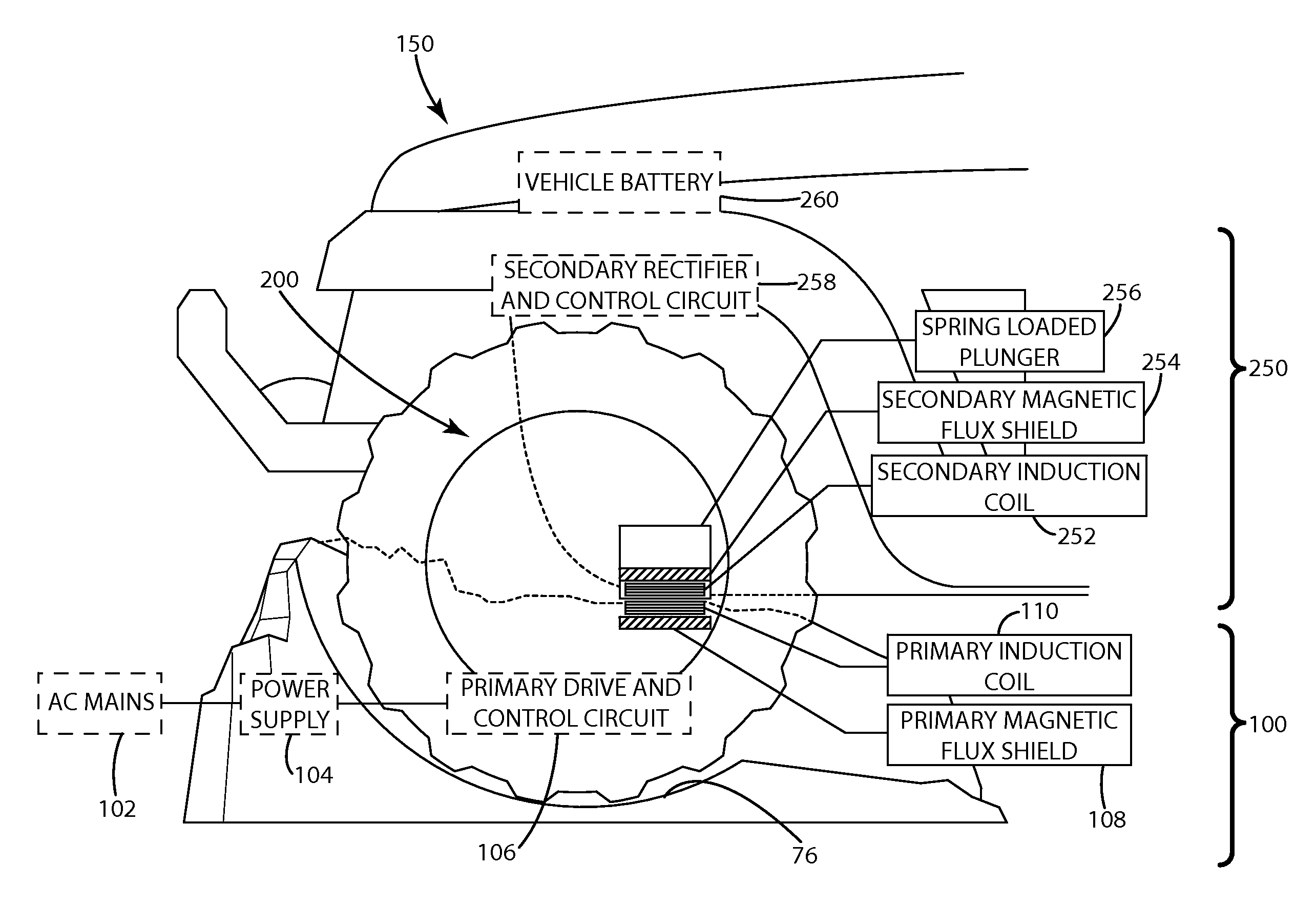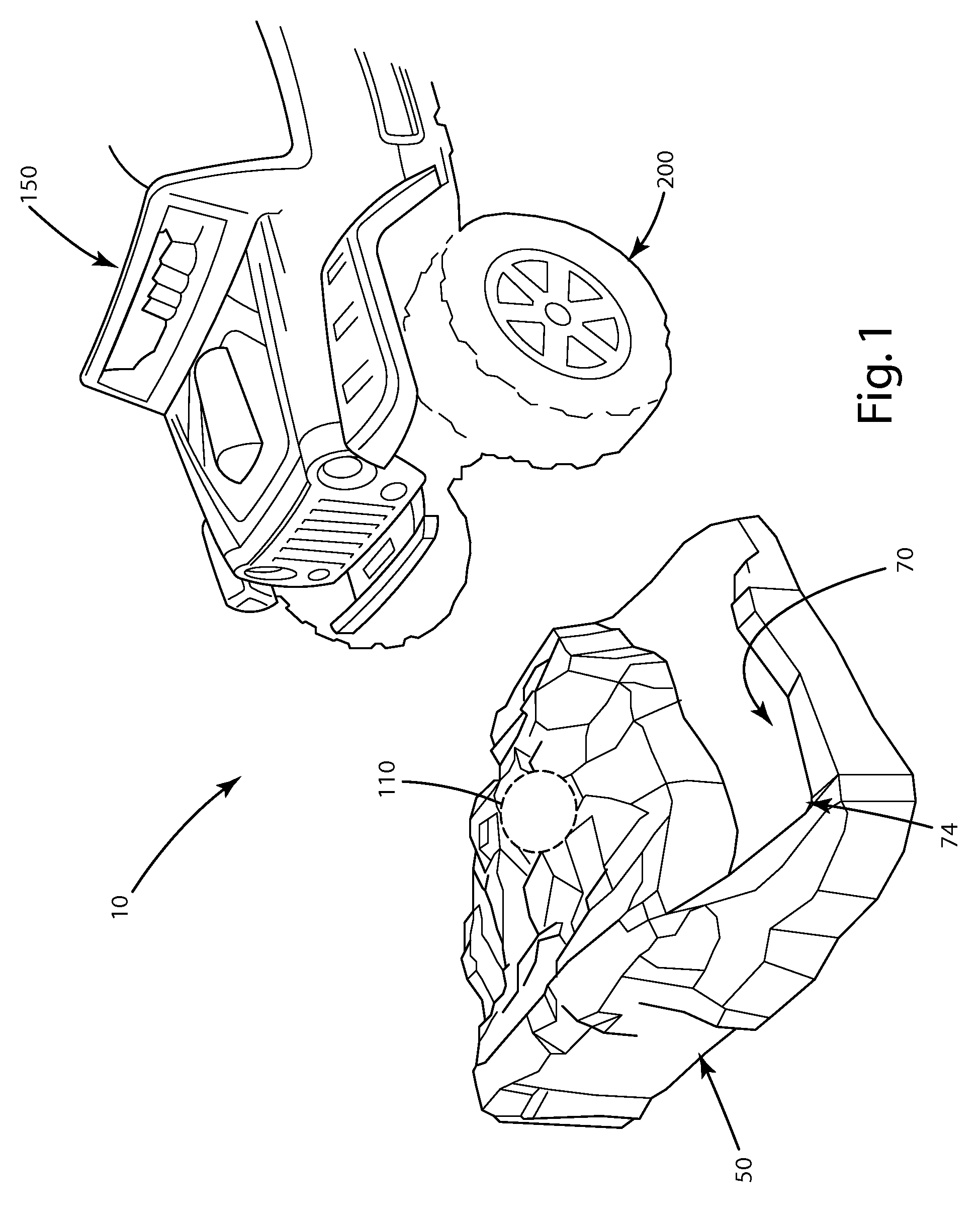Inductive charging system for electric vehicle
a charging system and electric vehicle technology, applied in the field of electric vehicle charging systems, can solve the problems of insufficient charging, insufficient charging, and insufficient charging, and achieve the effect of safe, simple and efficient charging
- Summary
- Abstract
- Description
- Claims
- Application Information
AI Technical Summary
Benefits of technology
Problems solved by technology
Method used
Image
Examples
first embodiment
I. First Embodiment
[0081]A first embodiment of the inductive vehicle charging system of the present invention is illustrated in the drawings and generally designated 10. The charging system 10 includes wheel chocks 50 and a vehicle 150. The wheel chocks 50 include alignment tracks 70 and a charging circuit 100. The vehicle 150 includes wheels 200 that align with the alignment tracks 70. The vehicle 150 includes a battery circuit 250.
[0082]As shown in FIGS. 1-3, the charging system 10 includes wheel chocks 50, alignment tracks 70, a primary charging coil 110, and a secondary coil 252. In FIG. 1, a toy vehicle 150 is shown with the wheels 200 aligned with the alignment tracks 70 as the toy vehicle 150 approaches the wheel chocks 50. The wheels 200 of the toy vehicle 150 enter the alignment tracks 70 and the toy vehicle 150 proceeds forward. The alignment tracks 70 terminate at front walls 74. After the wheels 200 contact the front walls 74 of the alignment tracks 70, the forward movem...
second embodiment
II. Second Embodiment
[0087]A second embodiment of the present invention is shown in FIG. 5. In this embodiment, the primary charging coil 110 is separated from the wheel chocks 50′ and mounted on a charging block 210. The vehicle 150″ moves forward until the wheels 200 contact the wheel chocks 50′ and the forward movement of the vehicle 150″ is impeded. This embodiment is designed such that, when the wheels 200 contact the wheel chocks 50′, the primary charging coil 110 and secondary coil 252 are in proper inductive charging alignment relative to one another. As shown in FIG. 5, the primary charging coil 110 and secondary coil 252 are generally horizontal, but at a slight angle relative to the road surface 300. This allows the secondary coil 252 to couple with and uncouple from the primary charging coil 110 during relative longitudinal movement of the vehicle and the charger. This arrangement also prevents damage to the coils 110, 252 if the vehicle 150″ unexpectedly moves rearward ...
third embodiment
III. Third Embodiment
[0088]A third embodiment of the invention is shown in FIGS. 6a and 6b. In this embodiment, the wheel chock 50″ includes a well 76′ and a hinge pin 92. A charging pedal 80 is hingedly connected to wheel chock 50″ at hinge pin 92. The charging pedal 80 includes a curved, rigid lever 82 with a forward portion 84 and a rearward portion 86. A primary coil platform 88 is hingedly connected to the lever 82 with hinge 90. Within hinge 90 is a hinge stop that prohibits the primary coil platform 88 from pivoting about hinge 90 past a predetermined platform angle θ relative to the rearward portion 86 of lever 82. Optionally, any other suitable device to prohibit platform 88 from pivoting about hinge 90 past platform angle θ may be used. Platform angle θ will be further described below. The primary charging coil 110 is positioned on the top surface of primary coil platform 88.
[0089]If a vehicle 150″ is not present, the wheel chock 50″ will have the orientation shown in FIG....
PUM
| Property | Measurement | Unit |
|---|---|---|
| frequency | aaaaa | aaaaa |
| frequency | aaaaa | aaaaa |
| frequency | aaaaa | aaaaa |
Abstract
Description
Claims
Application Information
 Login to View More
Login to View More - R&D
- Intellectual Property
- Life Sciences
- Materials
- Tech Scout
- Unparalleled Data Quality
- Higher Quality Content
- 60% Fewer Hallucinations
Browse by: Latest US Patents, China's latest patents, Technical Efficacy Thesaurus, Application Domain, Technology Topic, Popular Technical Reports.
© 2025 PatSnap. All rights reserved.Legal|Privacy policy|Modern Slavery Act Transparency Statement|Sitemap|About US| Contact US: help@patsnap.com



